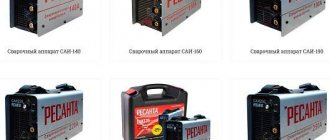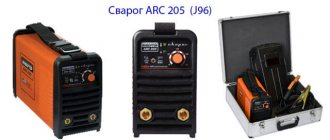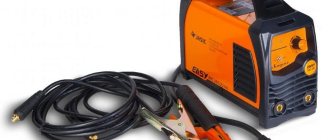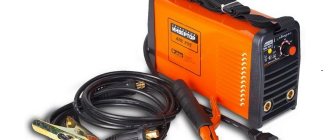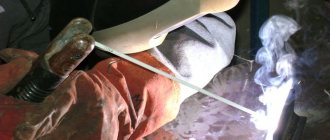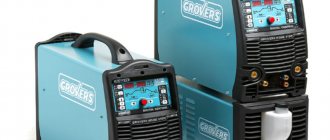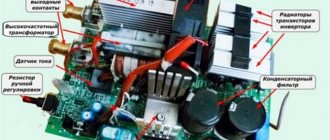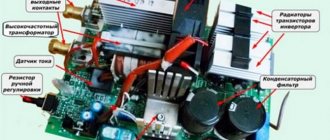Currently, transformer welding machines have been replaced by more mobile and easy-to-use devices. A welding inverter is used where it is necessary to convert direct current into alternating current, and the voltage value also changes. Compared to gasoline electric generators, rectifiers and transformers, the inverter device has small dimensions, relatively light weight and can be used even by non-professionals. In order to choose a good welding inverter, you need to familiarize yourself with the principle of its operation, design and the most productive models. We bring to your attention a detailed review of inverter welders.
Welding inverter: design
The inverter apparatus consists of an external housing, a control unit and a power unit. The outer case is a compact container equipped with connectors for electrical cables, a display, current regulators, a control panel, ventilation holes, a carrying handle and support legs. On the body of models designed for several types of welding, there is also an operating mode switch.
The control unit is represented by a microcircuit that controls PWM signals and controls the parameters of the current and voltage used in welding. To control the inverter, you must manually turn the resistor knob, which is located on the control panel. The soft start relay provides limitation of starting currents. The operation of the inverter device will automatically stop if the indicators associated with current and voltage exceed the permissible limit.
The power unit includes the following components:
- Network rectifier. Serves to convert alternating mains current with a frequency of 50 Hz into direct current. The diode bridge is mounted near the cooling radiator. If overheating cannot be avoided, the fuse trips and disconnects the entire device from the network.
- Mains voltage filter. Here the DC ripple is smoothed out to 1 percent.
- Thyristor or transistor intermediate links of high frequency. When passing through this element, direct current becomes high-frequency alternating current.
- Transformer. Thanks to it, the high voltage is reduced to the level required for welding
- Output rectifier. The high-speed diodes included in its composition rectify high-frequency alternating current.
- The protection unit protects the system from overheating, overloads, and sudden power surges in the network.
In this article:
But in welding units that generate direct and alternating current, different physical processes occur inside that determine the characteristics of the welding arc. The nature of the current is also different.
- What is alternating current
. In alternating current there is a frequency or oscillation. In a household network it is 50 Hz. This means that chaotically moving electrons moving along a sine wave are capable of changing their direction up to 100 times per second (2 times per cycle). Devices operating on alternating current are designated as AC (alternating current). - What is direct current
? In direct current, electrons (negatively charged particles moving from negative to positive) move in only one direction. The movement is not chaotic, but orderly. There are no fluctuations (frequencies), the voltage is more stable. Welding machines operating on direct current are designated as DC (direct current).
What is polarity?
When talking about direct current, it is worth mentioning polarity. Polarity is the direction of movement of negatively charged particles. In physics they always move from the minus terminal to the plus terminal. Alternating current does not have such a clearly defined direction.
In welding machines operating on direct current, the welder can choose which socket to install the connector of the holder (torch) and which ground cable. Since electrons always move from minus to plus, in each case the welding current will have certain properties.
With direct polarity (the holder is negative and the mass is positive), negatively charged particles move from the holder to the product. This promotes:
- rapid heating of the metal;
- increases penetration depth;
- saves consumption of coated electrode.
Straight polarity is relevant for welding thick steels.
Reverse polarity means connecting the holder to positive and the ground cable to negative. This triggers the electrons in reverse - the heat is concentrated not on the workpiece, but at the tip of the electrode, reducing heat input to the workpiece. Reverse polarity is used when welding thin sheets of iron to avoid burn-through. But using reverse polarity leads to overheating of the electrode tip and its accelerated melting.
Operating principle of the inverter device
inverter operation diagram
The electric current first flows to a bridge equipped with a cooling unit, consisting of high-power diodes, where the mains voltage is rectified. Then, high-capacity capacitors filter the ripples of the converted voltage, and it enters the inverter. There, high-frequency switching of transistors is carried out; the voltage is converted to alternating and decreases, and the current, on the contrary, increases. Filtering then follows using capacitors, and the current with the final voltage is supplied to the output terminals.
Modern welding inverters are a real find for novice technicians, since these devices are equipped with a number of useful functions:
- Hot start. With its help, igniting the arc will not be difficult. At the beginning of welding, the current value increases briefly, so high-quality penetration and a stable low weld height are guaranteed.
- Anti stick. When there is a possibility of the electrode sticking to the base metal, the welding current is sharply reduced. The equipment returns to normal operation immediately after the electrode is torn off.
- Arc force. It is used when it is necessary to force the arc in cases where the consumable material does not enter the weld pool in a timely manner. A short-term increase in current avoids weld defects by eliminating misplaced droplets of molten electrode.
Work principles
The welding inverter operates according to a simple and understandable scheme:
- it connects to the consumer network, where the alternating current frequency is 50 Hz;
- the current flows to the rectifier, where it is smoothed by a filter;
- thanks to the investor, the current strength for welding reaches 100-200A.
The process of converting alternating current takes a few minutes, after which you can begin welding seams or joining metal parts.
Find out how to choose the right welding transformer.
Types of welding machine
When choosing equipment, you should decide whether you need a welding inverter for a summer residence or whether you need equipment for electric welding on an industrial scale. Depending on the scope of application, inverter welding machines belong to the following classes:
- industrial. Such devices are designed for continuous use throughout the day; the duration of their load at maximum current reaches 100%. A powerful welding arc allows you to weld massive metal structures. The current strength is 250-500 A.
industrial inverter - professional. These devices are used for repairing pipes and manufacturing various metal frames. The current strength reaches 200-300 A.
professional inverter - domestic. The purpose of this technique is short-term welding work. It is necessary to take 5-10 minute breaks to avoid overheating. The current strength does not exceed 120-200 A.
household inverter
Many beginners are tormented by doubts about whether it is possible to choose an inverter welding machine that would meet the needs of both a novice craftsman and a professional. In this case, it is necessary to take into account the operating mode of the inverter. Depending on it, devices are divided into:
- intended for manual welding with an electric arc (MMA);
- semi-automatic (MIG/MAG);
- created for argon welding (TIG).
Disadvantages of inverters for manual welding
Like any technology, the inverter also has disadvantages. One of the most significant disadvantages is the presence of special requirements regarding the storage of the device. Proper storage conditions require, first of all, protecting it from dust, which can cause serious harm to the device.
It is precisely because of such requirements for storage conditions that manufacturing companies and construction organizations choose welding machines that are not so sensitive to the state of the external environment. Such devices, which include welding transformers and generators, can be safely left outdoors without worrying that this will seriously affect their technical characteristics. The disadvantage of inverters is their cost, which exceeds the price of welding transformers.
The choice of inverters today is very extensive
In addition, inverters require appropriate maintenance. In particular, to maintain devices in working condition, they must be thoroughly cleaned and purged after a long period of operation, which is not required by conventional welding transformers.
It is also important to start working on such a device correctly if it has just been brought in from the street. It is important to know that you can connect the inverter to the network and start working with it only 1.5–2 hours after moving it to a warm room. This requirement is due to the fact that condensation accumulates on the elements of the device, brought into the heat from the street, which can cause problems in its operation.
What materials is the equipment intended for?
The inverter is a universal device because it can be used for welding both ferrous and non-ferrous metals. For example, copper, steel, tungsten, cast iron, nickel, etc. With its help, you can connect parts even from materials that are difficult to weld, such as titanium, aluminum, and some types of steel.
Welding inverters are used to repair car bodies, repair sewer and water supply systems, erect greenhouse frames and fences for domestic use, connect wires and many other works.
Distinctive features of inverters
Types of welding power sources.
Having made sure that an inverter is suitable for performing a small amount of welding work at home, you should understand how the individual models of these current sources differ from each other.
There are two technologies for their production: MOSFET and IGBT. In the middle of the last century, MOSFET technology was developed. However, modern models made using IGBT technology turned out to be much more economical. In Europe, where they take energy saving seriously, only models made using this technology are available for sale.
In our retail network you can still find both types of these products. Therefore, there is a need to talk about their differences. Perhaps someone will consider it an appropriate option to purchase a less economical, but cheaper product made using MOSFET technology. They are more suitable for welding simple welds at home and are still more reliable than devices made using IGBT technology. With a small amount of work, the advantages associated with lower energy costs are not of practical importance.
IGBT inverter.
IGBT inverters operate at a frequency of 60-85 kHz, higher than that of a MOSFET inverter, which makes it possible to further reduce the weight of the entire structure. IGBT technology is more reliable in temperature characteristics. The emergency shutdown temperature for overheating is 90°C, which is approximately 30˚ higher than that of MOSFET technology devices.
But there is something to think about here too. If the duration of the actual welding is short, then this advantage may not be significant.
Regarding such an important issue for inverters as repairs, the opinions of those who perform it differ. MOSFET technology devices have more parts, but they have easier access, which is an advantage for repairs. Some people think so. Others believe that an IGBT technology inverter that is compact and has fewer elements fails less often and is easier to repair.
More significant is the fact that the IGBT inverter is better suited for welding not only ferrous, but also non-ferrous metals and cast iron.
Pros and cons of inverter welding
Operating an inverter when welding has many positive aspects:
- the device has high efficiency, which reaches 90%;
- the device has compact dimensions and light weight, which allows you to move it without much effort;
- the seam obtained as a result of using inverter welding has high strength and is protected from corrosion;
welding seam made by inverter - Welding can be done in horizontal, vertical positions, as well as at an angle;
- With high power and performance, such devices use energy sparingly;
- when welding metal, it is possible to avoid splashing of the molten material;
- sparking is minimal;
- the welding current in a machine of this type is adjusted smoothly;
- a small number of electrodes is required;
- a large number of inverter models allows you to choose the optimal one for the planned work;
- the qualifications of the person welding with an inverter do not matter, since this equipment is easy to operate and has a number of additional options.
The disadvantages of using inverter-type welding machines include:
- sensitivity of technology to environmental influences. When working in open areas, the equipment should be protected from dust particles, dirt, low temperatures, and moisture. To store equipment you will need to use a closed heated area.
- The high cost of high-quality inverters relative to welding transformers, as well as expensive repairs.
Basic classification of inverters:
- Household - the most convenient option if you carry out welding work at home, outside the city, or in the garage. Devices in this category are perfect for novice welders. Welding current range: from 160 to 200 A.
- Professional – ideal for employees of small companies, car repair shops and private entrepreneurs. A well-chosen unit will increase the operating time under difficult external conditions. Welding current range: from 200 to 300 A.
- Industrial – used in production, welding shops and large-scale facilities. Inverters in this category allow large volumes to be welded continuously, ensuring the required standard of weld quality. Welding current range: from 250 to 500 A.
Problems when using welding inverters. How to solve them
inverter repair
Despite the fact that choosing a welding inverter greatly simplifies many types of work, there is always the possibility of encountering problems. Knowing how to solve the problem yourself, you can not only prevent serious damage to expensive equipment, but also save time. Here are examples of the most common faults and how to fix them.
During prolonged welding, the machine turned off. This phenomenon should not be considered a malfunction, since the cessation of operation in this case is the result of overheating. As a rule, after a short break, the equipment is ready for use again.
The inverter does not turn on. It is necessary to check the mains voltage. Most likely, it is not high enough for welding work.
The welding arc periodically goes out or the molten electrode spatters. Pay close attention to the type and size of the electrode, select the optimal welding speed. If the manufacturer does not place recommendations on the packaging, then the suitability of the consumables can be calculated independently:
for each millimeter of the cross-section of the electrode there should be 20-40 A. The lower the welding speed, the less current is required.
When the indicators are in working condition, welding cannot be performed. In this case, you should check whether the wires are connected correctly and their integrity, or wait 20-30 minutes: the equipment may have overheated.
Adhesion of the electrode to the base metal. To avoid this, you should ensure that the voltage in the network is not lower than normal and that the device modules are in contact with the panel sockets. The network extension cable must have a cross-section exceeding 2.5 square millimeters, and the length of the extension cable must not exceed 40 meters. Finally, it is worth eliminating corrosion of contacts in the electrical circuit and more carefully preparing metal surfaces for connection.
If the above manipulations did not help, the device began to emit a burning smell or smoke came out of the case, the equipment should be taken to a service center.
Basic criteria for choosing an inverter
This is probably the simplest algorithm:
1.Welding current power;
2. Pricing policy;
3. Brand.
And now from this place in more detail:
Rated welding current
It provides optimal operating conditions taking into account the load duration (LOD) or on-duration (OND), indicated in %. For example, PN (PV) = 20% means that for 10 minutes of work, the immediate work process will be 2 minutes, and another 8 minutes, the device “rests”.
When determining this parameter of the welding inverter, proceed from the maximum thickness of the metal with which you will most often work. In accordance with this, the diameter of the required electrode will be determined. Usually the maximum permissible current for a particular device is taken into account. What does it mean. For example, if your operating current is 120 amperes, then you should select an inverter with a rating of 160-180, that is, you need to provide a power reserve of 30-50%. What is this for? I answer...
- To reduce the risk of equipment overheating at maximum welding current (semiconductors need good cooling);
- For protection in the event of an unexpected drop in network voltage to a minimum of 170-190 volts;
- When using a welding power cable more than 5 m long (due to voltage loss, the inverter power “falls” much below the nominal value);
- When working with a long (more than 15 m) power supply cable that has an inappropriate cross-section, the inverter voltage will also decrease, which will result in a decrease in operating current. So, choose a carrier with a cross-section of at least 4 square meters. mm. on copper, for example, PVA wire or rubber cable.
Typically, a range of 120 to 200 amperes of welding current is sufficient for domestic needs.
"Advice. If the “voltage” in the network is constantly reduced, take a model whose manual (operating manual) indicates the possibility of operation at reduced voltage and from a portable generator. They are usually equipped with a power factor corrector (PFC). They are often used as welding inverters for summer cottages, i.e. designed to operate in an unstable power supply network.”
Price:
There is not much to say here, but you should be aware of some subtle points, namely:
1. Inconsistency between the parameters set out in the OM and the actual ones
“Tip: Ask the store about the possibility of demonstrating the machine at maximum welding current and using the largest electrode diameter. For example, a 160 A device must function reliably with a 4 mm electrode, and a 200 A device with a 5 mm electrode. Any welder will tell you that for normal welding you need 40 amperes per 1 mm. electrode diameter. This is the minimum value."
2. Mismatch between the rated current and the name of the inverter
For example, the Blueweld Prestige 171/S brand has a current rating of 150A, although we usually assume that "171" is the current designation.
“Tip: Carefully read the data sheet on the rated welding current.”
3.Unknown brands
We are adults, so don't let greed overcome reason. Such devices are usually sold not in authorized outlets, but in ordinary hardware stores, since they do not have official service. And the mobile number of a “classy repair specialist” is not a warranty workshop with an actual address and landline telephone numbers.
“Ask for a certificate - the country of origin will be indicated there. Often Chinese consumer goods do not have markings and “sales consultants” can claim that the inverter was made, for example, in Austria. No certificate - smile and leave."
How to choose the right welding inverter
If during the 20th century the MMA inverter market was represented by a limited number of models, then at the present stage you can choose a reliable welding machine with any power factor and for any metal. To choose a good welding inverter, pay attention to the following:
- The technical characteristics of the device indicated in the passport must match the real ones. If the manufacturer overestimates these indicators in the documents, overloads and breakdowns cannot be avoided during operation of the equipment.
- As a rule, the low price of a welding machine and a short warranty period (less than 1-2 years) indicate low quality components.
- The power factor, or cos Ҩ (cosine phi), for most inverters will be no more than 0.75. And only for PFC devices that allow you to adjust the phase power, it ranges from 0.9 to 0.98.
- It is important whether the manufacturers of welding machines have provided a service center. It is best to proactively call there and inquire whether they accept devices of a particular brand for repair, and whether it is possible to quickly select components in the event of a breakdown.
The choice of an inverter in any case should depend on the type of metal that needs to be welded, its dimensions, the intensity of the work to be done, the operating conditions of the device, as well as the financial capabilities of the buyer. Whether the device is imported or domestic is not the most indicative criterion when choosing.
How to properly cook by welding, video instruction
Let’s say you just need a welding machine for housework, but you don’t know how to weld properly. The video material presented below will help you understand this process once and for all.
But first, a little theory. To begin with, we list the items a worker needs for welding:
- 1. Protective mask.
- 2. Suede mittens.
- 3. Tools for removing slag.
- 4. Welding unit.
- 5. Electrode or special wire.
- 6. Protective suit.
To make a high-quality weld, the first step is to develop practical welding skills. Without a doubt, each subsequent seam you make will be better than the previous one, so it’s best to try your hand at simple surfaces first. An integral part of welding work is safety precautions; under no circumstances start work without gloves and a mask. The metal that you will weld must be thoroughly cleaned with sandpaper or a file, this is necessary so that ignition of the arc does not cause problems and the weld is neat, since dirt and rust interfere with this.
Work order
The welding machine is always equipped with two special wires, at the ends of which there are steel clamps; the electrode is fixed in the first clamp, the second must be connected to the metal that needs to be welded. Welding work is performed in the following order:
- First you need to install the electrode in the clamp.
- After this, we attach the clamp of the second wire to the part that we will weld.
- Now, by lightly tapping the electrode on the metal, we ignite the electric arc.
- Next, you need to slowly make forward movements with the electrode in the place where you want to weld.
- After welding has been carried out in a small area, you should pause to perform assessment work on the quality of the seam.
- If necessary, remove the slag with a hammer or brush.
- Next, we carry out the work to the end, according to the same principle.
The result of your work should be a weld. And even though it won’t be beautiful and even the first time, gradually, when you gain experience, the result of welding work will become exactly what you need.
Review of the best inverter welding machines
The 2022 rating of the best welding inverters was compiled based on an analysis of numerous customer reviews, tests of welding machines, and a survey of employees of industrial enterprises. If you are still wondering how to choose a welding inverter, which brand, what useful functions it should have, take a closer look at the models described below.
Choosing an industrial inverter
Aurora PRO STRONGHOLD 500
Aurora PRO STRONGHOLD 500. A high-performance universal device that can be used in industry and construction, for communications repair and mechanical engineering work, as well as for installation. Using such an inverter, you can weld both thick-walled parts and small elements. The welding current is 40 - 500 A, current consumption is 38.4 A, supply voltage is 380 V. The device can be operated at temperatures from -20 to +50 degrees Celsius, as well as in conditions of high humidity. Thanks to the CarbonGouging function, you can plan a metal surface using a carbon electrode. The weight of the device is no more than 40 kg; 4 wheels are provided for its movement. Warranty period – 2 years.
SVAROG ARC 400 (Z312)
SVAROG ARC 400 (Z312). The equipment is intended for intensive use in industrial conditions, therefore it has reliable protection against overheating and mechanical damage. Thanks to it, you can quickly carry out deep penetration of surfaces with significant thickness, as well as complex alloys. Welding current is 30 – 400 A, current consumption is 27 A, supply voltage is 380 V. High-quality metal connection occurs even when using hoses up to 20 meters long. The manufacturer's warranty is 5 years.
FOXWELD VD-400I
FOXWELD VD-400I. The equipment will be useful in shipyards, railways, metal products factories, and in production. With its help you can weld stainless and ordinary steel, cast iron, aluminum. The welding current is 20 - 400 A, the supply voltage is 380 V. Tunnel ventilation allows you to avoid breakdowns that occur under the influence of moisture and dust.
Which professional inverter should you choose?
Interskol ISA-250/10.6
Interskol ISA-250/10.6. The model is designed for welding in conditions of low voltage, high loads, it will successfully complete the job, even if the metal surfaces have damage in the form of old paint or corrosion. Can be used both in everyday life and in medium-sized production. The welding current has a range of 31 - 225 A, supply voltage - 220 V.
Svarog REAL MIG 200
Svarog REAL MIG 200 (N24002). The device can weld ferrous metals and aluminum. Its important advantage is its versatility, namely the ability to be used for both manual arc welding and semi-automatic welding. Flux cored wire welding is possible. After stopping the feed, the wire is burned out and, thanks to this, does not stick in the weld pool. Welding current is 10 - 200A, consumed - 35 A, voltage - 220 V.
Aurora SPEEDWAY 160
Aurora SPEEDWAY 160. The inverter can operate in semi-automatic mode or carry out manual arc or argon arc welding. This makes it indispensable in car repair shops, in the country, and in small-scale production. Welding current ranges from 50 to 160A. The supply voltage is 220 V. Using this device, you can also weld thin metal.
Which inverter to choose for household needs
WESTER IWT200
WESTER IWT200. The device is easy to operate, has small dimensions and light weight. It cannot be used to carry out complex household work, but for beginners this inverter is as convenient and intuitive as possible. The model uses 30-40% less electricity than analogues. The welding current is 10-200 A, the current consumption is 20.3 A, the supply voltage is 220 V. The control elements are located on a separate board, so in the event of a breakdown, repairing the equipment will not be too expensive.
Aurora MINIONE 1800
Aurora MINIONE 1800. The device can be used in construction, agriculture, and when assembling metal structures. The welding current is 20 -180 A, current consumption is 31 A, supply voltage is 220 V. The system is ventilated only if it overheats. The device is equipped with a 2 m cable, an electrode holder, a ground clamp, and a storage case.
CEDAR MMA 220F
CEDAR MMA 220F. The undeniable advantage of this model is the preservation of operating qualities when the voltage drops to 140 V. Thanks to the built-in blinds, the mechanism is protected from dirt and moisture, which makes it suitable for use in field conditions. The welding current is 20-220 A, the supply voltage is 220 V. In addition to electric arc welding, the device can perform argon arc welding.
Previously, we published a detailed review of inexpensive welding inverters, which you can find here.
Areas of use
Based on this comparison of the operation of devices with alternating and direct current, we can conclude that the transformer is suitable for periodic welding of non-critical structures made of low-carbon steels.
It is advisable that welding be carried out in the lower position. At the same time, the welder must have certain qualifications, otherwise the seams will be very bad. The transformer will “survive” in construction conditions, frequent transportation, and dusty rooms. This is the optimal brew for a summer house, garage, to save money. Video source: Vitaly M
But AC transformers can also be useful for professional applications. For example, when welding coated electrodes on aluminum or rusty metal that cannot be cleaned. They are better than inverters because constantly changing the direction of electron flow helps break down aluminum oxide or contaminants on the surface. Direct current is not capable of this (only in combination with a pulse)
Inverters are better for beginners to learn how to cook. It is easier to work with them in all spatial positions, as well as to weld:
Changing the polarity will help weld thin metal 1-2 mm without burns. But inverters require more careful care and careful handling, otherwise frequent breakdowns will be expensive.
For professional activities or a private workshop, it is better to buy AC/DC welding machines. By switching from alternating to direct current, you can weld any metal efficiently and enjoy the pleasant rustle of the electric arc.
Useful tips for a beginner
- Before purchasing expensive equipment, it would be advisable to see it in action. Testing of inverter welding machines can be carried out both by the manufacturer and by users who have already purchased an inverter. To compare the models you like, just find a suitable video on YouTube.
- You should definitely find out in advance what comes with the inverter. In addition to the accompanying documents, an electrode holder and a grounding clamp must be present.
- If it is important for you in which country the inverter was produced, then here is the geographic location of the most common brands: Svarog, Bars, Aurora, Brima - China; Forsazh, Neon, Elitech, Resanta, GRPZ – Russia; ESAB-Sweden; EWM, Fubag - Germany.


